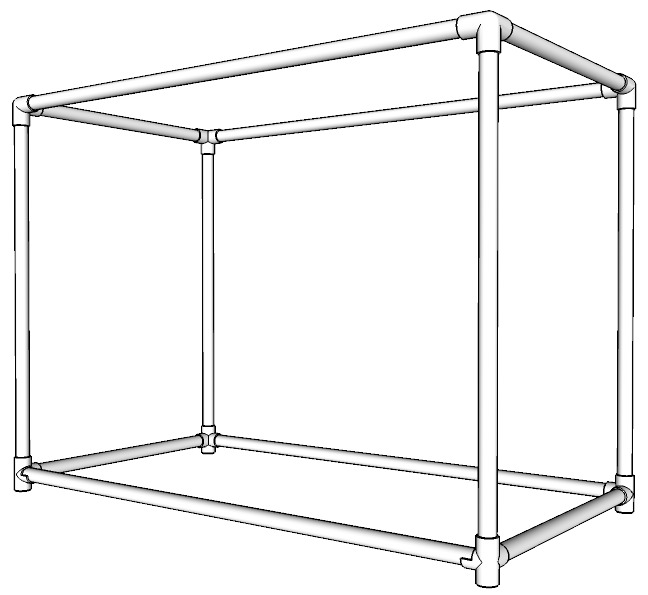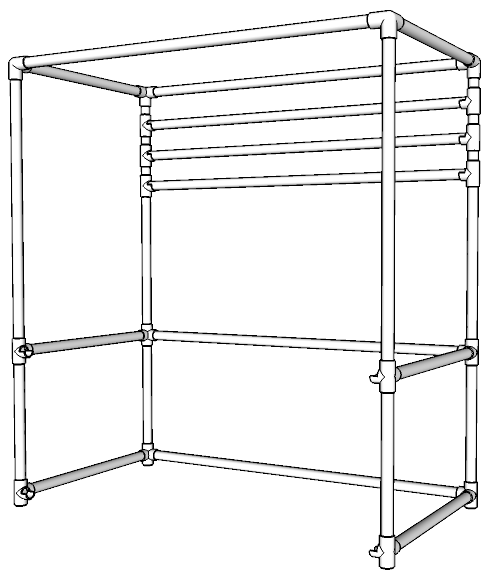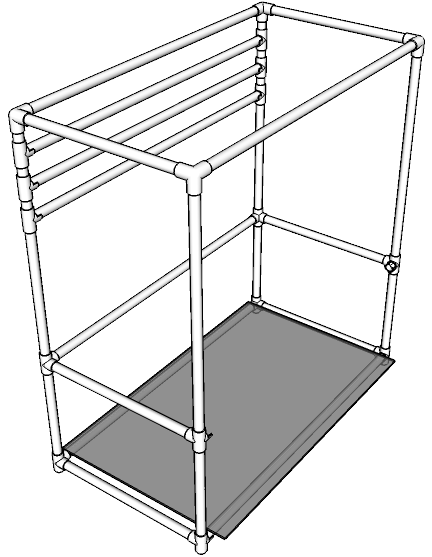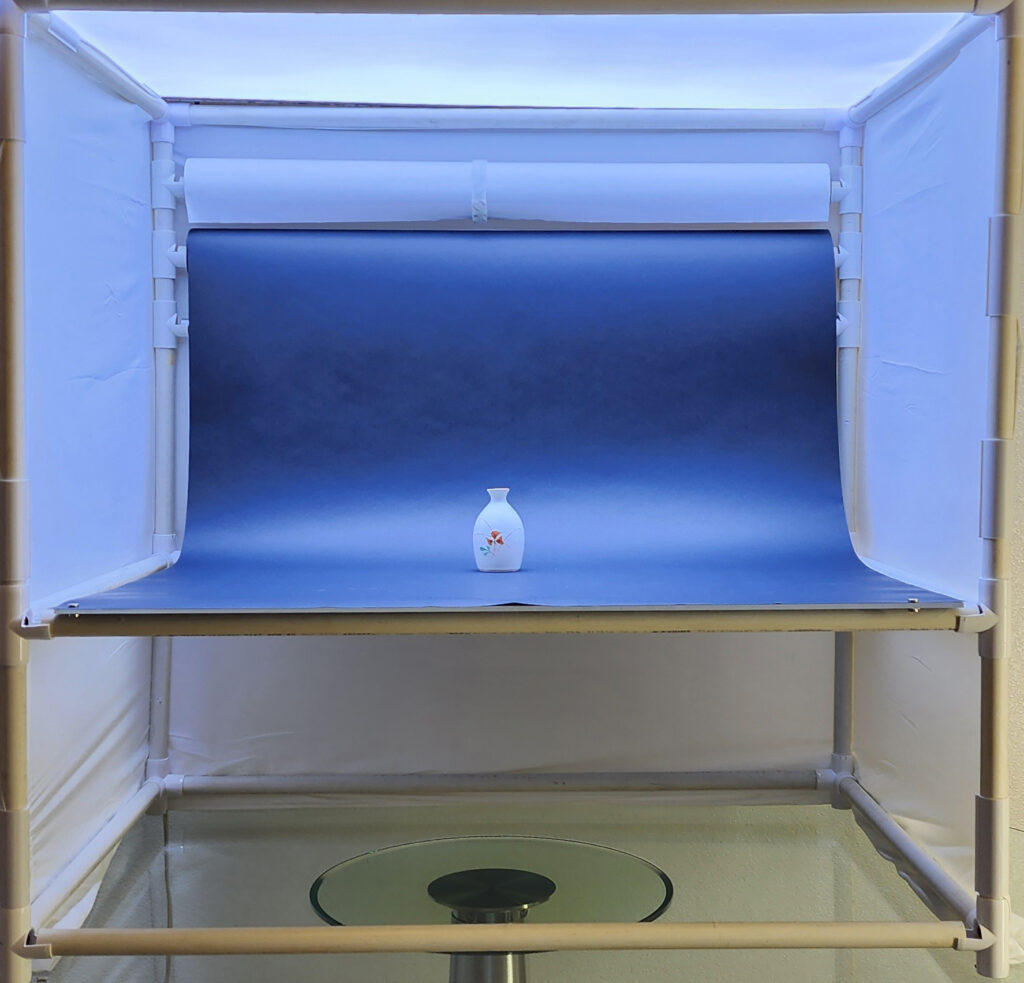Your cart is currently empty!
Taller Tabletop Light Box

Okay, so we now get the basic concept of creating a modular PVC box, but how do we increase the height, and still be able to use the original layout? We’ll explore how to safely stack our boxes with minimal modification. Increasing the height by 10″ to 12″ creates more than enough clearance for photographing most items that would be shot in a desktop light booth. Average height for a table or desk is 30″, so with subjects taller than 4′, shooting them in a tabletop light box studio gets a bit more difficult, and the taller tabletop light box can easily be converted to a floor model.
Click for Assembly Video, Step-by-Step Instructions, and Materials List
Now let’s add some height, and while we’re at it, let’s add a few rails or rods for hanging rolls of paper, curtains, custom back drops, etc. Take a close look at the 3 way tee modification (the same basic modification of the 4 way corner). The rods, still 3/4″ PVC, or even 3/4″ galvanized EMT, for their ability to be used with strong magnets, may be placed wherever you’d like. Just be sure to cut your PVC posts as symmetrically, as possible. I like to leave around 1″ pipe exposed, between each of the modified tees. PRO TIP – customize in whatever dimensions work best for your needs. If you have trouble figuring out exactly how long to make all of the cuts on the back posts, put your back posts together and make a final measurement against the front posts (the ones without the tees). Making sure all four corner posts are exactly the same height becomes a breeze.


Let’s add a movable cross member to our light box and something usable as a shelf. I love acrylic, but it’s expensive. Depending on how large and thick you need for a sheet, it can end up costing more than your entire light box. Repurposing a sheet of tempered glass from an old end table, can work, but acrylic isn’t as easily broken. Using 1/4″ plywood is also an inexpensive option, or even thick corrugated cardboard, but a clear shelf allows for some of the coolest bottom-lit shots, through colored or white paper, or any other backdrop material! Shallow LED lights can fit below, or you can place the shelf on the middle rung, which makes room for very large light fixtures. If you have a large glass table, you can make due with lighting below it!
PRO TIP – The clips/clamps shown in the Parts section make fitting flat bed sheets an extremely easy task, allowing you to make a very taut cover around your new studio. If you frequently photograph items that are highly reflective, you can line the inside of the light box with sheet, and forego the rolls of paper. I’ve learned through trial and error that lustrous finishes can be quite a challenge.
Since I prefer to stand when I’m taking pictures or video, I like the height of the upper level of this light box for shooting smaller items. You may find that you rarely have a need to modify your layout. Many people simply need to catalogue a large amount of smaller collectibles, family heirlooms, artwork, etc. However, with the popularity of online selling, capturing fantastic images can add a significant amount of money to a seller’s bottom line. Good photography can make the difference between an item selling, or not! I’m always amazed at how much money people leave on the table, due to poor quality images. I know there are people that make a healthy living buying items that are poorly photographed at a significant discount and capitalize on relisting the same items with beautiful pictures and better descriptions. In the next example, we’ll walk you through adding one more level to create the Floor Model Light Box Studio.

Dimensions
Approximate dimensions are: Width – 3′, Height – 3′, Depth – 2′.
It’s better to make your pipe cuts a bit too large, than a bit too small, if you plan on adding accessories, such as 36″ paper rolls. You can always trim your pipes later. A twin sheet is the perfect size for this light box.
Using a miter box and saw will produce much straighter cuts and also makes it possible for you to make your own custom fittings.
Materials
- The Basic Box (Example of our Basic Light Box) – DIY Cost: Around $50
- Extra bits for Lift Kit – Under $30
- White twin flat sheet for diffuser – $6
- 36″ by 100′ roll of white paper – $32 (OPTIONAL)
- 30″ by 20″ sheet of poster board – $.50 (Dollar Tree!)
- Acrylic sheet 30″x40″x1/4″ – OPTIONAL – Plan on $100, or more
- Laminated board from Home Depot (OPTIONAL) – ten bucks
- Light source – converted LED TV – FREE! Many inexpensive lighting options may be found with a bit of searching. Check our video links for free tutorials
Directions
- Cut 3/4″ PVC to length:
- 6 pieces at 37 5/8″
- 6 pieces at 24 1/2″
- 4 pieces at 22 15/16″
- 4 pieces at 12″
- Modify four 3/4″ PVC 4 way corner fittings, as shown on our products pages. Two 4 Way Connector Saddle – RIGHT and two 4 Way Connector Saddle – LEFT. The saddles should be cut approximately 1/16″ above center, to allow for the rails to be able to ‘snap’ into place.
- Assemble – Connect two 4 way corner connectors to the ends of one 37 5/8″ piece (this will be the back) and two modified 4 way corners to another 37 5/8″ pipe (this is the front).
- Connect the front and back rails by adding one 24 1/2″ PVC pipe to each side, inserted into the 4 way fittings.
- You should have your bottom level completed.
- Repeat the steps above, for creating your middle tier.
- For the top rails, use the four 3 way corner connectors, adding the above-mentioned pipe measurements.
- Connect the bottom level to the middle level with the four 12″ pipes, leaving the four 22 15/16″ pipes as vertical risers for attaching the middle level to the upper level of the box.
- Cover with the sheet, as shown above and use the ABS Snap Clamps to secure it. It should be a tight stretch.
- There is no need to use glue for this build. The stretched flat sheet keep everything in place!

